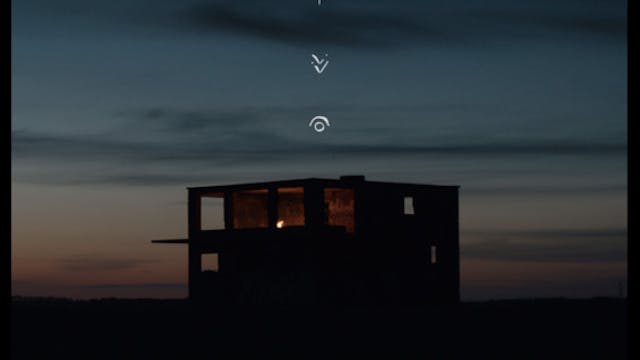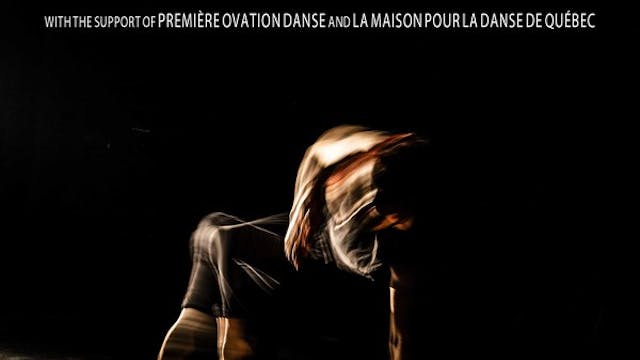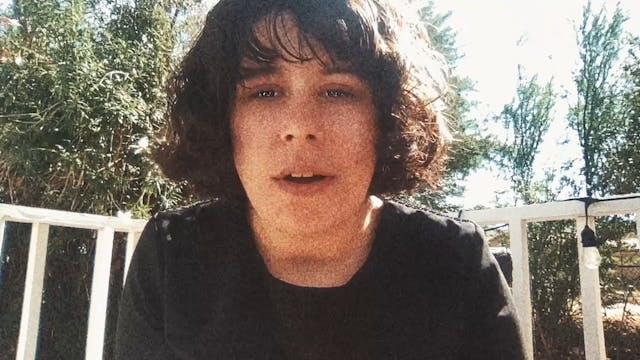LEXI short film, audience reactions (director interview)
FESTIVAL AUDIENCE FEEDBACK VIDEOS
•
11m
LEXI, 22min., USA, Experimental
Directed by Chloe Chen
Lexi, a desperate actress, can't perform well in front of the camera because of her tragic past and introverted and manic-depressive personality. She can only release herself when she is alone. When she was hesitating whether to give up her acting career, the director who cooperated with her ten years ago talked about his SINS......
Get to know the filmmaker:
1. What motivated you to make this film?
I have written many stories about myself during my college application. However, I realized I couldn’t relate to the stories I wrote in the personal statement anymore. I changed a lot during the summer of 2021 and my time in New York. So I want to reflect on my new experience. It's not dramatic and attractive like many of my high school stories. But because this experience was new and had never been told about, I wanted to make a film about it. Also, I watched many great movies during my first semester at University. They are niche and are very special to me. They focused on the expression of emotion instead of plot or dialogue. As a result, I also wanted to make this kind of film. I had never written or shot this type of film before, so it was a challenge and an attempt.
As I said, I watched many great films during the audio semester. Among these, the most impressive ones are Girlhood and Madeline’s Madeline. I was amazed by the dance scenes in Girlhood. There’s both euphoria and sadness in the dance scene, which depicts the pain of youth quite well. Madeline’s Madeline uses a very different visual and auditory language to show a process of subverting power relations (rebellion of youth, questioning of the creative leader.) It visualizes the character’s emotions. Both films emphasize long takes, which could be boring, but I immersed myself in them. I was attracted to this kind of untraditional way of telling stories. As a result, I adopted some characteristics of slow cinema. What’s more, the content of my film is similar to La La Land and Modern Love season 1, episode 3: Take Me As I Am, Whoever I Am. La La Land is most commendable for embedding traditional musical elements into modern films, making people feel that music and dance are flowing and integrated with modern cinema. Color is an essential aesthetic element in La La Land. The color of the whole film adopts saturated warm tones and unnatural light effects, creating an elegant, dramatic retro visual effect. It is also endowed with significant meanings and a variety of expressions. The heroine of Take Me As I Am, Whoever I Am is a well-written bipolar character. At the beginning of the story, Lexi (Anne Hathaway) is at the grocery store during a euphoric, manic high. The grocery store scenes are shot like a musical. However, she can shift from mania to depression within very short periods. Both La La Land and Take Me As I Am, Whoever I Am tend to be retro, and I really like their style. As a result, I imitated some of their camera movements and set design. I utilized much high saturated color so that the film would look retro. I also let the DP use a diffuser so the image would have a film look. Not only do I like the retro visual effect, but also like retro music. I love disco and funk very much, so I chose the song Be My Lady by Kool & The Gang. It’s one of my dream to shoot a dance scene with disco music.
This film is inspired by a real conversation between my boyfriend and me. He asked me to act a role in his short film. But when I practiced the line, I couldn’t make him satisfied. She was a very energetic character, and I couldn’t perform the line very well. I realized that I had changed a lot, and this was not how I used to be. I fell in love with movies when I was in junior high school. My teacher always invited us to engage in role-play or dramatization, from which my interest in writing scripts and directing actions originated. I could let go of myself before on the stage in front of everyone, and I even won a prize at school, but I couldn’t do this anymore. This made me feel sad and think about what could have caused this drastic change in my personality.
2. From the idea to the finished product, how long did it take for you to make this film?
It only took about three weeks to make this film. However, we did prepare a lot for the film, especially for the location scouting, production design, and casting. Starting with location scouting, I was trying to achieve the goal of finding a vintage-style apartment. Thus my AD and I went to several places. Firstly, we went to a place called Blue Moon Hotel; it was a lovely place with a beautiful balcony. However, we didn’t choose this site for filming because it seemed too much like a hotel, not an apartment with vitality. Secondly, we searched for locations through an app called Giggster, and we found a beautiful place where many movie stars had taken photographs. The owner sent me a contract at night; this was the first time I’d ever viewed such a formal contract for location rentals. She asked me for insurance that covers 1-6million dollars. Also, there were many restrictions on the agreement in expression that we could not understand. Therefore, we hired a lawyer to explain things to us. It was quite an annoying but meaningful experience because I learned something from it. After thorough consideration, we decided not to rent the place. Since it was a very old house with so many rules and restrictions on the contract, I was afraid we might get into trouble. My only goal was to concentrate on the film entirely, and I didn’t want to be distracted by all those matters. Finally, we found the location where I would love to shoot.
We’ve also done so much work on casting. I had a very high standard on the characters since it’s a character-based film. For Lexi, my protagonist, since the character is mainly based on my personal experiences, I wanted the actress to look like who had similar sadness. In addition, because of the dancing scene, the actress was required to dance well in both traditional and modern forms. We’ve cast some dancers, but most of them couldn’t say the line as desperately as I wanted. After weeks of casting, I still couldn’t find one candidate, even for backups. However, there was one who showed up just one week before shooting. She was almost the perfect role for Lexi. For the male character, I was pretty lucky. With only two to three auditions, I’ve found the ideal candidates.
3. How would you describe your film in two words!?
Stream of consciousness, spur-of-the-moment.
4. What was the biggest obstacle you faced in completing this film?
The shoot went well due to the amount of time I spent on the pre-production, except for the rooftop scene. We didn’t expect that the weather would become so bad. The sunlight kept changing, and it made the image looks unbalanced. We have to use a diaphragm to cover the sunlight. What’s worse, it’s very windy on the rooftop, which caused a bad sound quality. We shot for hours for this short scene, and I was worried that my cast and crew were losing patience. Luckily, things turned out to be great. However, we didn’t expect the hotel’s noise to be heard while shooting the stair scene. We couldn’t solve this problem, and we could only do ADR, but it’s hard to dub a crying scene.
5. What were your initial reactions when watching the audience talking about your film in the feedback video?
I’m very surprised that the audience interpreted my imperfect, unconventional, and stream-of-consciousness work in such a good way. This is a short film for a class called First Person Narrative, so as the name implies, it can be said that it was made only for myself, and I probably didn’t expect others to understand or like it. After a series of busy production and post-production, I always forget the original intention of the film. I was enlightened again after watching the feedback video.
6. When did you realize that you wanted to make films?
I fell in love with movies and developed the habit of writing film reviews in junior high school. My teacher always invited us to engage in role-play or dramatization, from which my interest in writing scripts and directing actions originated. Since then, I have had access to many films and written down film reviews after watching them. Gradually, my understanding of films has deepened. Also, out of interest, I participated in a Mini-Oscar textbook drama competition. As it turned out, my team won the competition, and I won the best screenplay award. I felt unprecedented confidence and moved, and I hoped to explore the area of films.
7. What film have you seen the most in your life?
Pulp Fiction.
8. What other elements of the festival experience can we and other festivals implement to satisfy you and help you further your filmmaking career?
It would be great if there were some panels and opportunities to meet some film sales companies.
9. You submitted to the festival via FilmFreeway. How has your experiences been working on the festival platform site?
The experience is quite good. It’s more convenient and straightforward than submitting directly on the official website. Also, you can easily check the submission status.
10. What is your favorite meal?
Hotpot.
11. What is next for you? A new film?
I’m currently working on a short documentary film called CrazyLaugh. CrazyLaugh is the first Chinese stand-up comedy club in New York. It was established only a few months ago, but they have already gained many audiences. Three core members are interviewed: Baries, Nicholas, and Rachel. They were not professional stand-up comedians; they all had their own job in New York. Nicholas is a real estate agent. Rachel and Berries are marketers. They have all given very unique, memorable, and touching stories. Baries tells about how and why she established this club; Nicholas tells about how stand-up comedy saved him from his busy work; Rachel tells about how stand-up comedy has connected her and her own people in the US. They have successfully created a platform not only for Asian Americans but also for Chinese in the US, who are lonely and have always been ignored by the mainstream media.
Up Next in FESTIVAL AUDIENCE FEEDBACK VIDEOS
-
ZEPHYR short film, audience reactions
ZEPHYR, 33min., UK, Musical
Directed by Jack Tierney
Following the journey of a young boy into old age, this 30 minute visual poem is about finding balance - a dynamic exploration into the unconscious processes that shape our everyday lives. From the playfulness of childhood to the complexities o... -
BLANK SPACE short film, audience reac...
BLANK SPACE, 5min., Canada, Experimental
Directed by Elias Djemil-Matassov
Sounds. Bright lights. Demands to meet. Fast-paced everyday life. What happens when we press pause and allow ourselves to explore the space inside our creative minds? A blank space where all possibilities exist.Get to kn...
-
BLACK RAINBOW short film, audience re...
BLACK RAINBOW, 9min., Egypt, Experimental
Directed by Omar Aly Hussein
A girl entering her home showing her dull
Life then she falls asleep and have a panic attack showing parallel time line of her subconscious struggling with a dance with a voice over narrating how she feels and other poems to e...


